Cybercrime and its Impact on Children and Youth: A Criminology Report
VerifiedAdded on 2020/06/04
|7
|2587
|81
Report
AI Summary
This report delves into the pervasive issue of cybercrime and its detrimental effects on children and youth. It defines cybercrime, highlighting its various forms, including cyberstalking, cyberbullying, and child grooming, and emphasizes the role of the internet and mobile phones in facilitating these offenses. The report explores the psychological and emotional impacts on victims, including increased rates of suicide, and discusses the involvement of offenders in exploiting modern ICT for malicious purposes. It covers topics such as child pornography, online sexual exploitation, and the challenges faced by parents in protecting their children. The report also touches upon the lack of law enforcement and the need for parental vigilance, offering insights into warning signs and preventative measures. The report concludes by emphasizing the increasing accessibility of child abuse material and the role of technology in reducing the risk of revealing the identities of the offenders, and provides recommendations for protecting children and youth from cybercrime.

Criminology
Paraphrase This Document
Need a fresh take? Get an instant paraphrase of this document with our AI Paraphraser
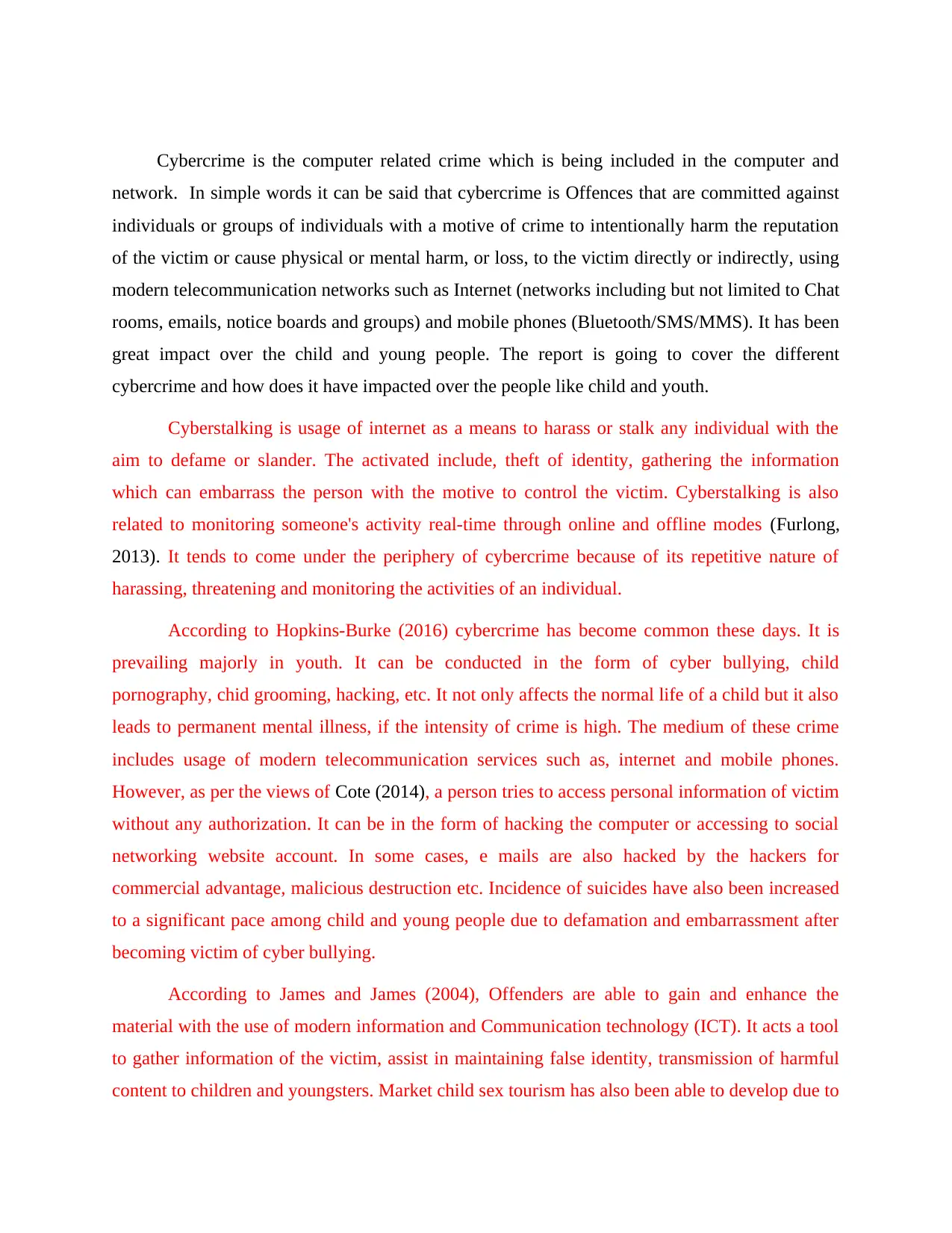
Cybercrime is the computer related crime which is being included in the computer and
network. In simple words it can be said that cybercrime is Offences that are committed against
individuals or groups of individuals with a motive of crime to intentionally harm the reputation
of the victim or cause physical or mental harm, or loss, to the victim directly or indirectly, using
modern telecommunication networks such as Internet (networks including but not limited to Chat
rooms, emails, notice boards and groups) and mobile phones (Bluetooth/SMS/MMS). It has been
great impact over the child and young people. The report is going to cover the different
cybercrime and how does it have impacted over the people like child and youth.
Cyberstalking is usage of internet as a means to harass or stalk any individual with the
aim to defame or slander. The activated include, theft of identity, gathering the information
which can embarrass the person with the motive to control the victim. Cyberstalking is also
related to monitoring someone's activity real-time through online and offline modes (Furlong,
2013). It tends to come under the periphery of cybercrime because of its repetitive nature of
harassing, threatening and monitoring the activities of an individual.
According to Hopkins-Burke (2016) cybercrime has become common these days. It is
prevailing majorly in youth. It can be conducted in the form of cyber bullying, child
pornography, chid grooming, hacking, etc. It not only affects the normal life of a child but it also
leads to permanent mental illness, if the intensity of crime is high. The medium of these crime
includes usage of modern telecommunication services such as, internet and mobile phones.
However, as per the views of Cote (2014), a person tries to access personal information of victim
without any authorization. It can be in the form of hacking the computer or accessing to social
networking website account. In some cases, e mails are also hacked by the hackers for
commercial advantage, malicious destruction etc. Incidence of suicides have also been increased
to a significant pace among child and young people due to defamation and embarrassment after
becoming victim of cyber bullying.
According to James and James (2004), Offenders are able to gain and enhance the
material with the use of modern information and Communication technology (ICT). It acts a tool
to gather information of the victim, assist in maintaining false identity, transmission of harmful
content to children and youngsters. Market child sex tourism has also been able to develop due to
network. In simple words it can be said that cybercrime is Offences that are committed against
individuals or groups of individuals with a motive of crime to intentionally harm the reputation
of the victim or cause physical or mental harm, or loss, to the victim directly or indirectly, using
modern telecommunication networks such as Internet (networks including but not limited to Chat
rooms, emails, notice boards and groups) and mobile phones (Bluetooth/SMS/MMS). It has been
great impact over the child and young people. The report is going to cover the different
cybercrime and how does it have impacted over the people like child and youth.
Cyberstalking is usage of internet as a means to harass or stalk any individual with the
aim to defame or slander. The activated include, theft of identity, gathering the information
which can embarrass the person with the motive to control the victim. Cyberstalking is also
related to monitoring someone's activity real-time through online and offline modes (Furlong,
2013). It tends to come under the periphery of cybercrime because of its repetitive nature of
harassing, threatening and monitoring the activities of an individual.
According to Hopkins-Burke (2016) cybercrime has become common these days. It is
prevailing majorly in youth. It can be conducted in the form of cyber bullying, child
pornography, chid grooming, hacking, etc. It not only affects the normal life of a child but it also
leads to permanent mental illness, if the intensity of crime is high. The medium of these crime
includes usage of modern telecommunication services such as, internet and mobile phones.
However, as per the views of Cote (2014), a person tries to access personal information of victim
without any authorization. It can be in the form of hacking the computer or accessing to social
networking website account. In some cases, e mails are also hacked by the hackers for
commercial advantage, malicious destruction etc. Incidence of suicides have also been increased
to a significant pace among child and young people due to defamation and embarrassment after
becoming victim of cyber bullying.
According to James and James (2004), Offenders are able to gain and enhance the
material with the use of modern information and Communication technology (ICT). It acts a tool
to gather information of the victim, assist in maintaining false identity, transmission of harmful
content to children and youngsters. Market child sex tourism has also been able to develop due to
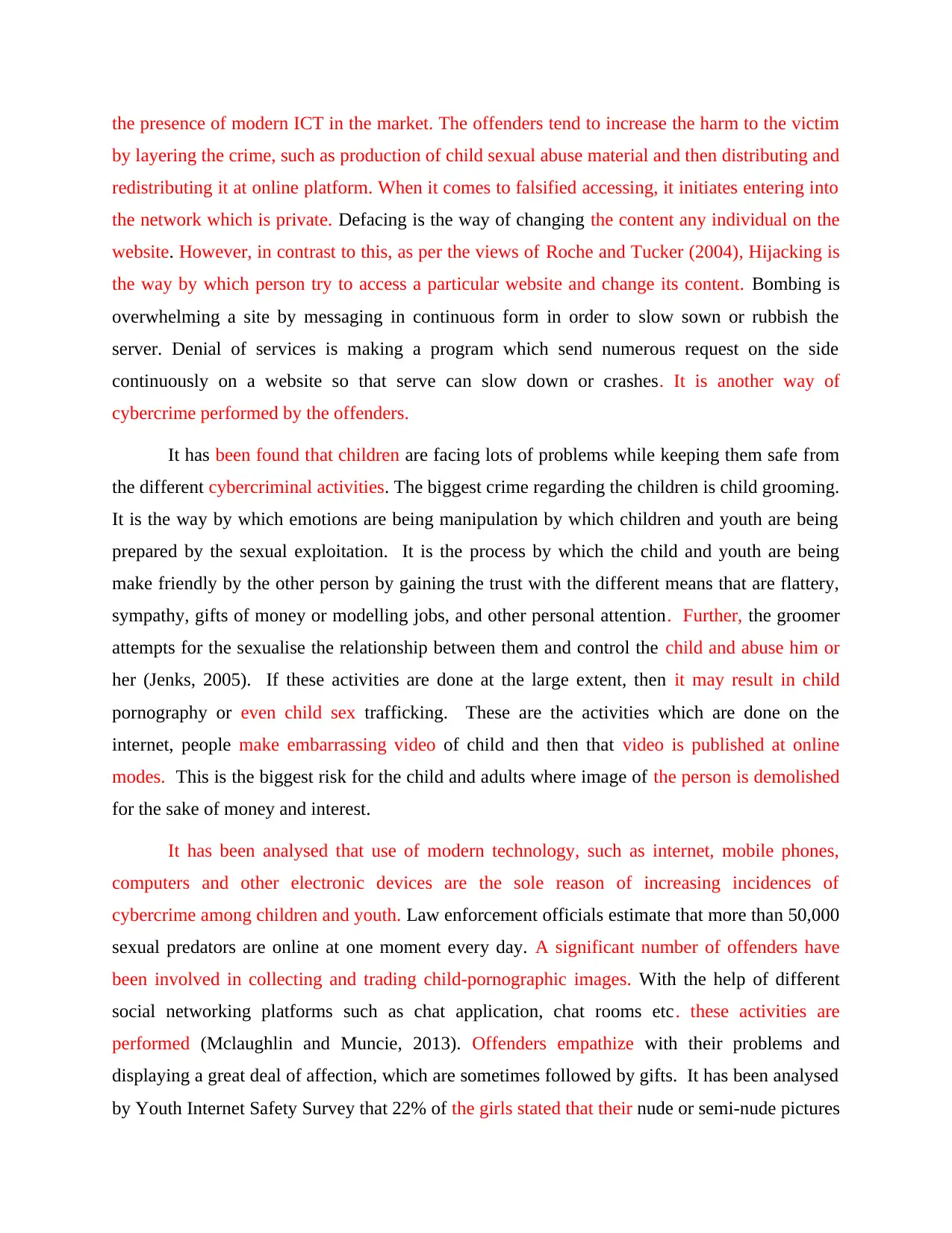
the presence of modern ICT in the market. The offenders tend to increase the harm to the victim
by layering the crime, such as production of child sexual abuse material and then distributing and
redistributing it at online platform. When it comes to falsified accessing, it initiates entering into
the network which is private. Defacing is the way of changing the content any individual on the
website. However, in contrast to this, as per the views of Roche and Tucker (2004), Hijacking is
the way by which person try to access a particular website and change its content. Bombing is
overwhelming a site by messaging in continuous form in order to slow sown or rubbish the
server. Denial of services is making a program which send numerous request on the side
continuously on a website so that serve can slow down or crashes. It is another way of
cybercrime performed by the offenders.
It has been found that children are facing lots of problems while keeping them safe from
the different cybercriminal activities. The biggest crime regarding the children is child grooming.
It is the way by which emotions are being manipulation by which children and youth are being
prepared by the sexual exploitation. It is the process by which the child and youth are being
make friendly by the other person by gaining the trust with the different means that are flattery,
sympathy, gifts of money or modelling jobs, and other personal attention. Further, the groomer
attempts for the sexualise the relationship between them and control the child and abuse him or
her (Jenks, 2005). If these activities are done at the large extent, then it may result in child
pornography or even child sex trafficking. These are the activities which are done on the
internet, people make embarrassing video of child and then that video is published at online
modes. This is the biggest risk for the child and adults where image of the person is demolished
for the sake of money and interest.
It has been analysed that use of modern technology, such as internet, mobile phones,
computers and other electronic devices are the sole reason of increasing incidences of
cybercrime among children and youth. Law enforcement officials estimate that more than 50,000
sexual predators are online at one moment every day. A significant number of offenders have
been involved in collecting and trading child-pornographic images. With the help of different
social networking platforms such as chat application, chat rooms etc. these activities are
performed (Mclaughlin and Muncie, 2013). Offenders empathize with their problems and
displaying a great deal of affection, which are sometimes followed by gifts. It has been analysed
by Youth Internet Safety Survey that 22% of the girls stated that their nude or semi-nude pictures
by layering the crime, such as production of child sexual abuse material and then distributing and
redistributing it at online platform. When it comes to falsified accessing, it initiates entering into
the network which is private. Defacing is the way of changing the content any individual on the
website. However, in contrast to this, as per the views of Roche and Tucker (2004), Hijacking is
the way by which person try to access a particular website and change its content. Bombing is
overwhelming a site by messaging in continuous form in order to slow sown or rubbish the
server. Denial of services is making a program which send numerous request on the side
continuously on a website so that serve can slow down or crashes. It is another way of
cybercrime performed by the offenders.
It has been found that children are facing lots of problems while keeping them safe from
the different cybercriminal activities. The biggest crime regarding the children is child grooming.
It is the way by which emotions are being manipulation by which children and youth are being
prepared by the sexual exploitation. It is the process by which the child and youth are being
make friendly by the other person by gaining the trust with the different means that are flattery,
sympathy, gifts of money or modelling jobs, and other personal attention. Further, the groomer
attempts for the sexualise the relationship between them and control the child and abuse him or
her (Jenks, 2005). If these activities are done at the large extent, then it may result in child
pornography or even child sex trafficking. These are the activities which are done on the
internet, people make embarrassing video of child and then that video is published at online
modes. This is the biggest risk for the child and adults where image of the person is demolished
for the sake of money and interest.
It has been analysed that use of modern technology, such as internet, mobile phones,
computers and other electronic devices are the sole reason of increasing incidences of
cybercrime among children and youth. Law enforcement officials estimate that more than 50,000
sexual predators are online at one moment every day. A significant number of offenders have
been involved in collecting and trading child-pornographic images. With the help of different
social networking platforms such as chat application, chat rooms etc. these activities are
performed (Mclaughlin and Muncie, 2013). Offenders empathize with their problems and
displaying a great deal of affection, which are sometimes followed by gifts. It has been analysed
by Youth Internet Safety Survey that 22% of the girls stated that their nude or semi-nude pictures
⊘ This is a preview!⊘
Do you want full access?
Subscribe today to unlock all pages.

Trusted by 1+ million students worldwide
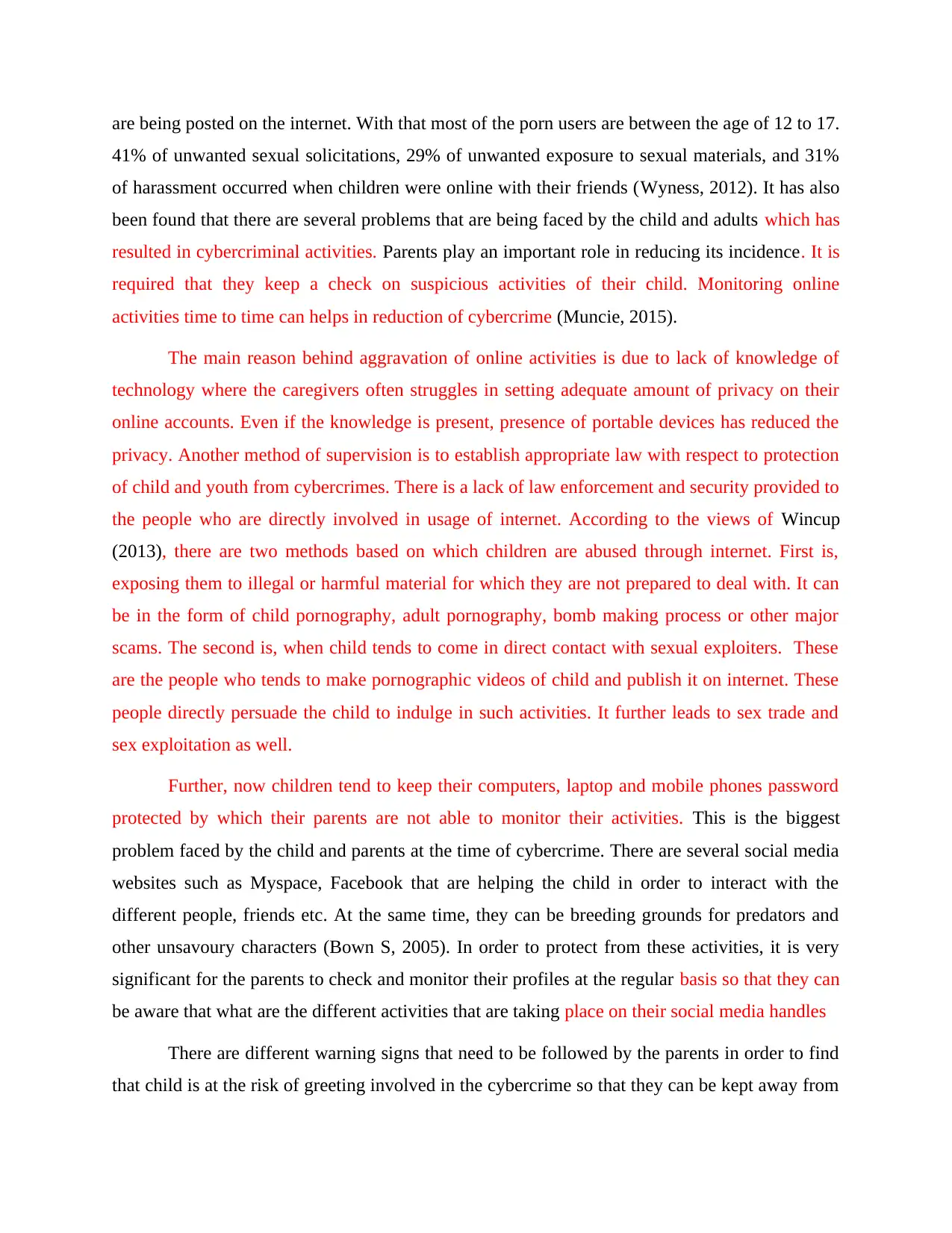
are being posted on the internet. With that most of the porn users are between the age of 12 to 17.
41% of unwanted sexual solicitations, 29% of unwanted exposure to sexual materials, and 31%
of harassment occurred when children were online with their friends (Wyness, 2012). It has also
been found that there are several problems that are being faced by the child and adults which has
resulted in cybercriminal activities. Parents play an important role in reducing its incidence. It is
required that they keep a check on suspicious activities of their child. Monitoring online
activities time to time can helps in reduction of cybercrime (Muncie, 2015).
The main reason behind aggravation of online activities is due to lack of knowledge of
technology where the caregivers often struggles in setting adequate amount of privacy on their
online accounts. Even if the knowledge is present, presence of portable devices has reduced the
privacy. Another method of supervision is to establish appropriate law with respect to protection
of child and youth from cybercrimes. There is a lack of law enforcement and security provided to
the people who are directly involved in usage of internet. According to the views of Wincup
(2013), there are two methods based on which children are abused through internet. First is,
exposing them to illegal or harmful material for which they are not prepared to deal with. It can
be in the form of child pornography, adult pornography, bomb making process or other major
scams. The second is, when child tends to come in direct contact with sexual exploiters. These
are the people who tends to make pornographic videos of child and publish it on internet. These
people directly persuade the child to indulge in such activities. It further leads to sex trade and
sex exploitation as well.
Further, now children tend to keep their computers, laptop and mobile phones password
protected by which their parents are not able to monitor their activities. This is the biggest
problem faced by the child and parents at the time of cybercrime. There are several social media
websites such as Myspace, Facebook that are helping the child in order to interact with the
different people, friends etc. At the same time, they can be breeding grounds for predators and
other unsavoury characters (Bown S, 2005). In order to protect from these activities, it is very
significant for the parents to check and monitor their profiles at the regular basis so that they can
be aware that what are the different activities that are taking place on their social media handles
There are different warning signs that need to be followed by the parents in order to find
that child is at the risk of greeting involved in the cybercrime so that they can be kept away from
41% of unwanted sexual solicitations, 29% of unwanted exposure to sexual materials, and 31%
of harassment occurred when children were online with their friends (Wyness, 2012). It has also
been found that there are several problems that are being faced by the child and adults which has
resulted in cybercriminal activities. Parents play an important role in reducing its incidence. It is
required that they keep a check on suspicious activities of their child. Monitoring online
activities time to time can helps in reduction of cybercrime (Muncie, 2015).
The main reason behind aggravation of online activities is due to lack of knowledge of
technology where the caregivers often struggles in setting adequate amount of privacy on their
online accounts. Even if the knowledge is present, presence of portable devices has reduced the
privacy. Another method of supervision is to establish appropriate law with respect to protection
of child and youth from cybercrimes. There is a lack of law enforcement and security provided to
the people who are directly involved in usage of internet. According to the views of Wincup
(2013), there are two methods based on which children are abused through internet. First is,
exposing them to illegal or harmful material for which they are not prepared to deal with. It can
be in the form of child pornography, adult pornography, bomb making process or other major
scams. The second is, when child tends to come in direct contact with sexual exploiters. These
are the people who tends to make pornographic videos of child and publish it on internet. These
people directly persuade the child to indulge in such activities. It further leads to sex trade and
sex exploitation as well.
Further, now children tend to keep their computers, laptop and mobile phones password
protected by which their parents are not able to monitor their activities. This is the biggest
problem faced by the child and parents at the time of cybercrime. There are several social media
websites such as Myspace, Facebook that are helping the child in order to interact with the
different people, friends etc. At the same time, they can be breeding grounds for predators and
other unsavoury characters (Bown S, 2005). In order to protect from these activities, it is very
significant for the parents to check and monitor their profiles at the regular basis so that they can
be aware that what are the different activities that are taking place on their social media handles
There are different warning signs that need to be followed by the parents in order to find
that child is at the risk of greeting involved in the cybercrime so that they can be kept away from
Paraphrase This Document
Need a fresh take? Get an instant paraphrase of this document with our AI Paraphraser
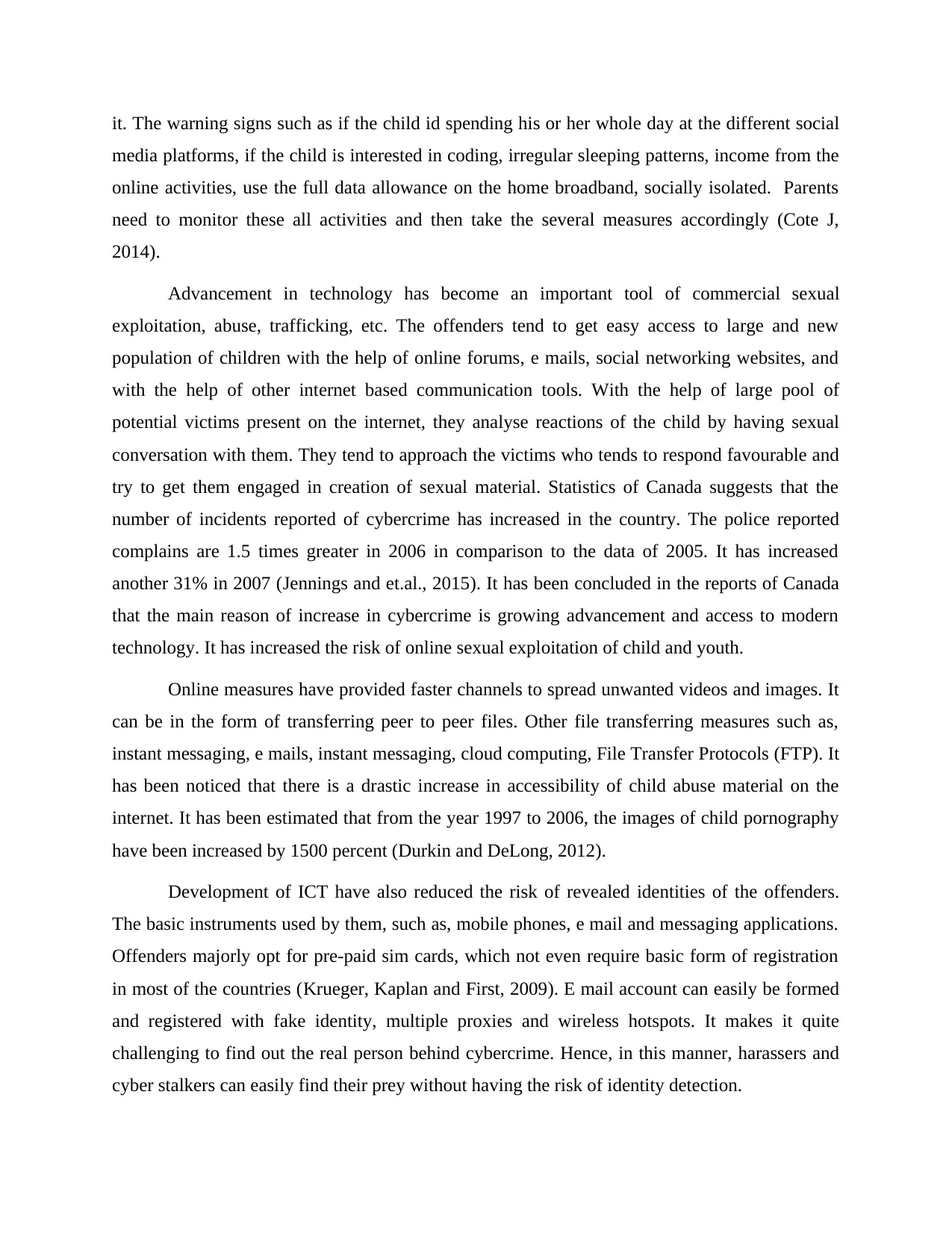
it. The warning signs such as if the child id spending his or her whole day at the different social
media platforms, if the child is interested in coding, irregular sleeping patterns, income from the
online activities, use the full data allowance on the home broadband, socially isolated. Parents
need to monitor these all activities and then take the several measures accordingly (Cote J,
2014).
Advancement in technology has become an important tool of commercial sexual
exploitation, abuse, trafficking, etc. The offenders tend to get easy access to large and new
population of children with the help of online forums, e mails, social networking websites, and
with the help of other internet based communication tools. With the help of large pool of
potential victims present on the internet, they analyse reactions of the child by having sexual
conversation with them. They tend to approach the victims who tends to respond favourable and
try to get them engaged in creation of sexual material. Statistics of Canada suggests that the
number of incidents reported of cybercrime has increased in the country. The police reported
complains are 1.5 times greater in 2006 in comparison to the data of 2005. It has increased
another 31% in 2007 (Jennings and et.al., 2015). It has been concluded in the reports of Canada
that the main reason of increase in cybercrime is growing advancement and access to modern
technology. It has increased the risk of online sexual exploitation of child and youth.
Online measures have provided faster channels to spread unwanted videos and images. It
can be in the form of transferring peer to peer files. Other file transferring measures such as,
instant messaging, e mails, instant messaging, cloud computing, File Transfer Protocols (FTP). It
has been noticed that there is a drastic increase in accessibility of child abuse material on the
internet. It has been estimated that from the year 1997 to 2006, the images of child pornography
have been increased by 1500 percent (Durkin and DeLong, 2012).
Development of ICT have also reduced the risk of revealed identities of the offenders.
The basic instruments used by them, such as, mobile phones, e mail and messaging applications.
Offenders majorly opt for pre-paid sim cards, which not even require basic form of registration
in most of the countries (Krueger, Kaplan and First, 2009). E mail account can easily be formed
and registered with fake identity, multiple proxies and wireless hotspots. It makes it quite
challenging to find out the real person behind cybercrime. Hence, in this manner, harassers and
cyber stalkers can easily find their prey without having the risk of identity detection.
media platforms, if the child is interested in coding, irregular sleeping patterns, income from the
online activities, use the full data allowance on the home broadband, socially isolated. Parents
need to monitor these all activities and then take the several measures accordingly (Cote J,
2014).
Advancement in technology has become an important tool of commercial sexual
exploitation, abuse, trafficking, etc. The offenders tend to get easy access to large and new
population of children with the help of online forums, e mails, social networking websites, and
with the help of other internet based communication tools. With the help of large pool of
potential victims present on the internet, they analyse reactions of the child by having sexual
conversation with them. They tend to approach the victims who tends to respond favourable and
try to get them engaged in creation of sexual material. Statistics of Canada suggests that the
number of incidents reported of cybercrime has increased in the country. The police reported
complains are 1.5 times greater in 2006 in comparison to the data of 2005. It has increased
another 31% in 2007 (Jennings and et.al., 2015). It has been concluded in the reports of Canada
that the main reason of increase in cybercrime is growing advancement and access to modern
technology. It has increased the risk of online sexual exploitation of child and youth.
Online measures have provided faster channels to spread unwanted videos and images. It
can be in the form of transferring peer to peer files. Other file transferring measures such as,
instant messaging, e mails, instant messaging, cloud computing, File Transfer Protocols (FTP). It
has been noticed that there is a drastic increase in accessibility of child abuse material on the
internet. It has been estimated that from the year 1997 to 2006, the images of child pornography
have been increased by 1500 percent (Durkin and DeLong, 2012).
Development of ICT have also reduced the risk of revealed identities of the offenders.
The basic instruments used by them, such as, mobile phones, e mail and messaging applications.
Offenders majorly opt for pre-paid sim cards, which not even require basic form of registration
in most of the countries (Krueger, Kaplan and First, 2009). E mail account can easily be formed
and registered with fake identity, multiple proxies and wireless hotspots. It makes it quite
challenging to find out the real person behind cybercrime. Hence, in this manner, harassers and
cyber stalkers can easily find their prey without having the risk of identity detection.

REFERENCES
Books and Journal
Bourke, M. L., & Craun, S. W. (2014). Secondary traumatic stress among internet crimes against
children task force personnel: impact, risk factors, and coping strategies. Sexual Abuse, 26(6),
586-609.
Cote J (2014) Youth St ud ves fundamental issues and debates, London: Palgrave. Crlmnology: o
soclologco? introduct,ov. 3” edition. Ablngdon: Routledge,
Durkin, K. F., & DeLong, R. L. (2012). Internet crimes against children. In Encyclopedia of
Cyber Behavior (pp. 799-806). IGI Global.
Furlong A (2013) Youth studes- an introduction, London: Routledge.
Hopkins-Burke, R. (2016) Young people. Cnme and Justice, 2’ edition, Ab.ngdon Routledge.
James A & James A (2004) Constructing Cluidhood. Basingstoke: Paigrave.
Jenks C (2005) Childhood, 2 edition. London: Routledge.
Jennings, W., Gray, E., Hay, C., & Farrall, S. (2015). Collating longitudinal data on crime,
victimization and social attitudes in england and wales: a new resource for exploring long-term
trends in crime. British Journal of Criminology, 55(5), 1005-1015.
Krueger, R. B., Kaplan, M. S., & First, M. B. (2009). Sexual and other axis I diagnoses of 60
males arrested for crimes against children involving the Internet. CNS spectrums, 14(11), 623-
631.
Mclaughlin, E. and Muncie, J. (2013) The Sage Oict,onory of Cri rnir,ology. 3d edition, London:
Sage.
Mclaughlin, E. and Muncie, J. (eds) (2013) Crimirioloqicof Pcrspcctives: essential readings, 3d
edition, London: Sage.
Muncie, J. (2015) Youth and Crime: a critical introduction 4M edition. London: Sage
Muncie, J. Hughes, G & Mclaughlin, E. (2002) Youth Just,ce, london: Sage.
Newbum, T. (cd.) (2009) Key Readings in Criminology, Abingdon: Routledge.
Roche, J. and Tucker, S. (2004). Youth of Society, 2nd edition, London, Sage.
Books and Journal
Bourke, M. L., & Craun, S. W. (2014). Secondary traumatic stress among internet crimes against
children task force personnel: impact, risk factors, and coping strategies. Sexual Abuse, 26(6),
586-609.
Cote J (2014) Youth St ud ves fundamental issues and debates, London: Palgrave. Crlmnology: o
soclologco? introduct,ov. 3” edition. Ablngdon: Routledge,
Durkin, K. F., & DeLong, R. L. (2012). Internet crimes against children. In Encyclopedia of
Cyber Behavior (pp. 799-806). IGI Global.
Furlong A (2013) Youth studes- an introduction, London: Routledge.
Hopkins-Burke, R. (2016) Young people. Cnme and Justice, 2’ edition, Ab.ngdon Routledge.
James A & James A (2004) Constructing Cluidhood. Basingstoke: Paigrave.
Jenks C (2005) Childhood, 2 edition. London: Routledge.
Jennings, W., Gray, E., Hay, C., & Farrall, S. (2015). Collating longitudinal data on crime,
victimization and social attitudes in england and wales: a new resource for exploring long-term
trends in crime. British Journal of Criminology, 55(5), 1005-1015.
Krueger, R. B., Kaplan, M. S., & First, M. B. (2009). Sexual and other axis I diagnoses of 60
males arrested for crimes against children involving the Internet. CNS spectrums, 14(11), 623-
631.
Mclaughlin, E. and Muncie, J. (2013) The Sage Oict,onory of Cri rnir,ology. 3d edition, London:
Sage.
Mclaughlin, E. and Muncie, J. (eds) (2013) Crimirioloqicof Pcrspcctives: essential readings, 3d
edition, London: Sage.
Muncie, J. (2015) Youth and Crime: a critical introduction 4M edition. London: Sage
Muncie, J. Hughes, G & Mclaughlin, E. (2002) Youth Just,ce, london: Sage.
Newbum, T. (cd.) (2009) Key Readings in Criminology, Abingdon: Routledge.
Roche, J. and Tucker, S. (2004). Youth of Society, 2nd edition, London, Sage.
⊘ This is a preview!⊘
Do you want full access?
Subscribe today to unlock all pages.

Trusted by 1+ million students worldwide
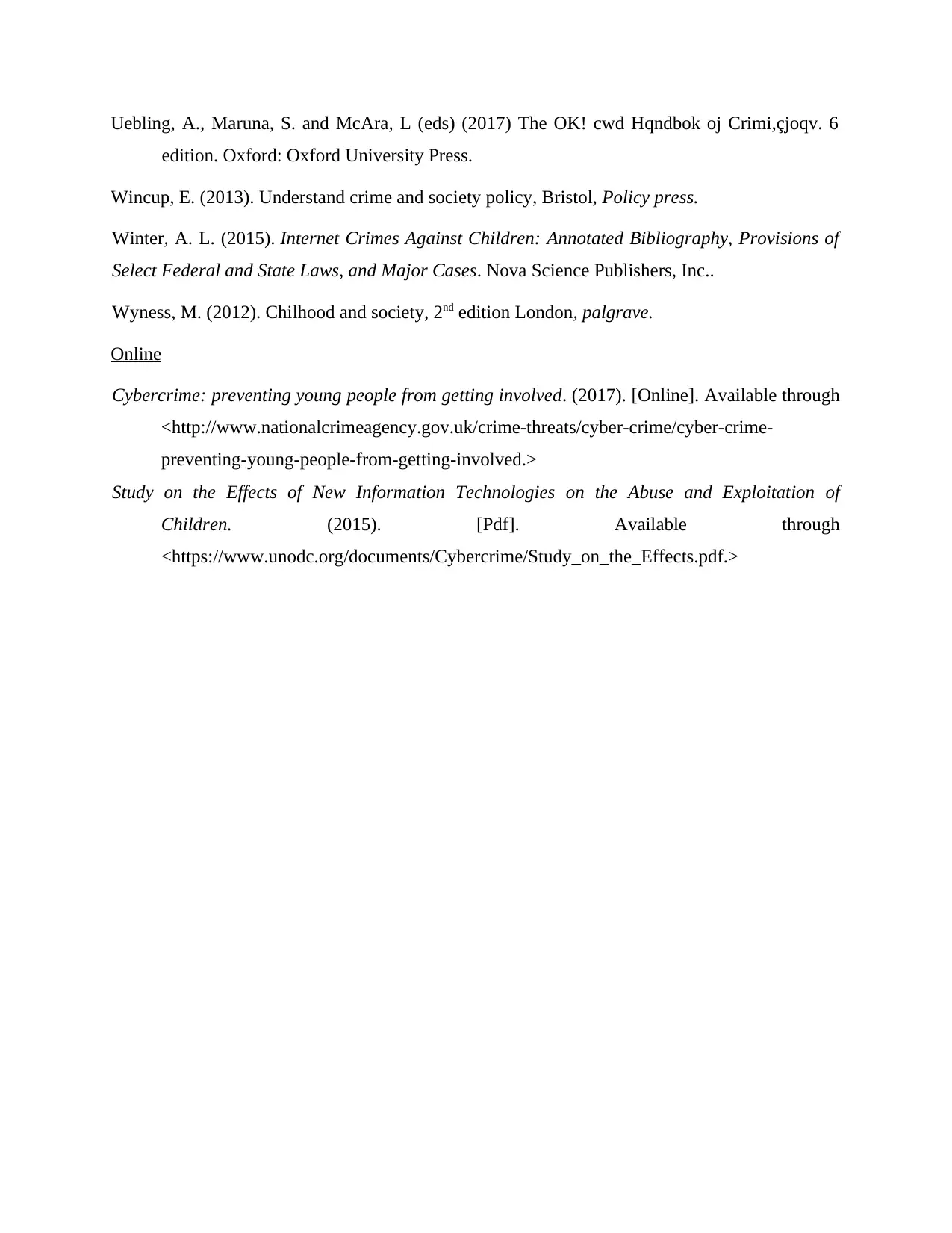
Uebling, A., Maruna, S. and McAra, L (eds) (2017) The OK! cwd Hqndbok oj Crimi,çjoqv. 6
edition. Oxford: Oxford University Press.
Wincup, E. (2013). Understand crime and society policy, Bristol, Policy press.
Winter, A. L. (2015). Internet Crimes Against Children: Annotated Bibliography, Provisions of
Select Federal and State Laws, and Major Cases. Nova Science Publishers, Inc..
Wyness, M. (2012). Chilhood and society, 2nd edition London, palgrave.
Online
Cybercrime: preventing young people from getting involved. (2017). [Online]. Available through
<http://www.nationalcrimeagency.gov.uk/crime-threats/cyber-crime/cyber-crime-
preventing-young-people-from-getting-involved.>
Study on the Effects of New Information Technologies on the Abuse and Exploitation of
Children. (2015). [Pdf]. Available through
<https://www.unodc.org/documents/Cybercrime/Study_on_the_Effects.pdf.>
edition. Oxford: Oxford University Press.
Wincup, E. (2013). Understand crime and society policy, Bristol, Policy press.
Winter, A. L. (2015). Internet Crimes Against Children: Annotated Bibliography, Provisions of
Select Federal and State Laws, and Major Cases. Nova Science Publishers, Inc..
Wyness, M. (2012). Chilhood and society, 2nd edition London, palgrave.
Online
Cybercrime: preventing young people from getting involved. (2017). [Online]. Available through
<http://www.nationalcrimeagency.gov.uk/crime-threats/cyber-crime/cyber-crime-
preventing-young-people-from-getting-involved.>
Study on the Effects of New Information Technologies on the Abuse and Exploitation of
Children. (2015). [Pdf]. Available through
<https://www.unodc.org/documents/Cybercrime/Study_on_the_Effects.pdf.>
1 out of 7
Related Documents
Your All-in-One AI-Powered Toolkit for Academic Success.
+13062052269
info@desklib.com
Available 24*7 on WhatsApp / Email
![[object Object]](/_next/static/media/star-bottom.7253800d.svg)
Unlock your academic potential
Copyright © 2020–2025 A2Z Services. All Rights Reserved. Developed and managed by ZUCOL.





